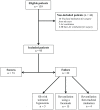Spontaneous Breathing for Panendoscopy? Retrospective Cohort and Results of a French Practice Survey
- PMID: 35005334
- PMCID: PMC8738874
- DOI: 10.1177/2473974X211065015
Spontaneous Breathing for Panendoscopy? Retrospective Cohort and Results of a French Practice Survey
Abstract
Objective: Avoiding tracheal intubation by using general anesthesia with spontaneous breathing (GASB) is attractive for upper airway panendoscopy. The aim of this study was to estimate the incidence of adverse events during panendoscopy under GASB and to assess the practices of French anesthesiologists.
Study design: Two-phase study: monocentric retrospective study and national survey.
Setting: University hospital center.
Methods: Patients who underwent a panendoscopy under GASB at the University Hospital of Angers between January 1 and December 31, 2014, were reviewed. Failure of GASB was defined as an episode of hypoxemia (SpO2 ≤88%) or the need for face mask ventilation with or without tracheal intubation. Then, we sent an electronic survey to all members of the French Society of Anaesthesia and Intensive Care.
Results: Among the 95 included patients, 22 (23%) experienced a failure of GASB: 3 tolerated hypoxemia, 15 had face mask ventilation episodes, and 4 were intubated. Three factors were associated with failure: obesity (odds ratio, 11.94; 95% CI, 3.20-44.64), history of difficult intubation defined as a Cormack score ≥3 (odds ratio, 6.20; 95% CI, 1.51-25.41), and laryngeal tumor (odds ratio, 2.81; 95% CI, 1.04-7.56). Among the 3930 members of the French Society of Anaesthesia and Intensive Care in 2018, 662 (16.8%) responded to the survey. The 2 preferred techniques to perform panendoscopy were intubation (62%) and intravenous sedation with spontaneous breathing (37%).
Conclusion: Although general anesthesia with orotracheal intubation remains the preferred technique for panendoscopy in France, GASB is an attractive alternative with a low failure rate. Risk factors for failure are obesity, history of difficult intubation, and laryngeal tumor.
Keywords: general anesthesia; national survey; otorhinolaryngologic surgical procedure; panendoscopy; spontaneous breathing.
© The Authors 2022.
Figures



Similar articles
-
A French survey of paediatric airway management use in tonsillectomy and appendicectomy.Paediatr Anaesth. 2003 Sep;13(7):584-8. doi: 10.1046/j.1460-9592.2003.01106.x. Paediatr Anaesth. 2003. PMID: 12950858
-
The laryngeal mask airway reliably provides rescue ventilation in cases of unanticipated difficult tracheal intubation along with difficult mask ventilation.Anesth Analg. 1998 Sep;87(3):661-5. doi: 10.1097/00000539-199809000-00032. Anesth Analg. 1998. PMID: 9728849 Clinical Trial.
-
Fiberoptic-guided intubation after insertion of the i-gel airway device in spontaneously breathing patients with difficult airway predicted: a prospective observational study.J Clin Anesth. 2016 Dec;35:287-292. doi: 10.1016/j.jclinane.2016.08.015. Epub 2016 Oct 10. J Clin Anesth. 2016. PMID: 27871545
-
Preoperative airway assessment - experience gained from a multicentre cluster randomised trial and the Danish Anaesthesia Database.Dan Med J. 2016 May;63(5):B5241. Dan Med J. 2016. PMID: 27127020 Review.
-
Converting to Intubation During Non-intubated Thoracic Surgery: Incidence, Indication, Technique, and Prevention.Front Surg. 2021 Oct 26;8:769850. doi: 10.3389/fsurg.2021.769850. eCollection 2021. Front Surg. 2021. PMID: 34765639 Free PMC article. Review.
Cited by
-
High Frequency Jet Ventilation or Mechanical Ventilation for Panendoscopy for Cervicofacial Cancer: A Retrospective Study.J Clin Med. 2023 Jun 14;12(12):4039. doi: 10.3390/jcm12124039. J Clin Med. 2023. PMID: 37373732 Free PMC article.
-
Spontaneous Ventilation With High-Flow Nasal Oxygen for Elective Suspension Microlaryngoscopy.OTO Open. 2023 May 20;7(2):e54. doi: 10.1002/oto2.54. eCollection 2023 Apr-Jun. OTO Open. 2023. PMID: 37220496 Free PMC article.
-
High-flow nasal oxygen for suspension laryngoscopy: a multicenter open-label study.J Int Med Res. 2022 Dec;50(12):3000605221140685. doi: 10.1177/03000605221140685. J Int Med Res. 2022. PMID: 36524243 Free PMC article.
References
-
- Jaquet Y, Monnier P, Van Melle G, et al.. Complications of different ventilation strategies in endoscopic laryngeal surgery: a 10-year review. Anesthesiology. 2006;104(1):52-59. - PubMed
-
- Orosco RK, Lin HW, Bhattacharyya N. Safety of adult ambulatory direct laryngoscopy: revisits and complications. JAMA Otolaryngol Head Neck Surg. 2015;141(8):685-689. - PubMed
-
- Klussmann JP, Knoedgen R, Wittekindt C, et al.. Complications of suspension laryngoscopy. Ann Otol Rhinol Laryngol. 2002;111(11):972-976. - PubMed
-
- Booth AWG, Vidhani K. Spontaneous ventilation using propofol TCI for microlaryngoscopy in adults: a retrospective audit. Anaesth Intensive Care. 2016;44(2):285-293. - PubMed
-
- Murdoch JA, Hyde RA, Kenny GN. Target-controlled remifentanil in combination with propofol for spontaneously breathing day-case patients. Anaesthesia. 1999;54(11):1028-1031. - PubMed
LinkOut - more resources
Full Text Sources

